Blog: These Three Amazon Inventory Management Mistakes Cost Me $10k (and counting)â¦
These Three Amazon Inventory Management Mistakes Cost Me $10k (and counting)â¦
Amazon inventory management: this logistical game of order management, sales, forecasts and operations is the unsexy nitty gritty of an Amazon business that could literally put you out of business if executed poorly. Well, unfortunately Jungle Stix has encountered the fate of having no inventory to sell on Amazon. While we can't sell anything at the moment, there are some good lessons to learn from this circumstance, and adjustments I could have made to lessen the blow of being out of stock.
Have you ever anticipated an event, salivated and savored the taste before it arrived, only to see it slip through your fingers? Is that what Jimi Hendrix calls Castles Made of Sand? Well, it appears that’s what has happened with Jungle Stix—right at the start of peak season we don't have anything to sell! While the cargo takes its time crossing the Pacific Ocean by boat, let's dig in to the details here….
Jungle Stix: Sales to Date
If you saw the last update of Jungle Stix, sales were sizzling, around $16k per month:
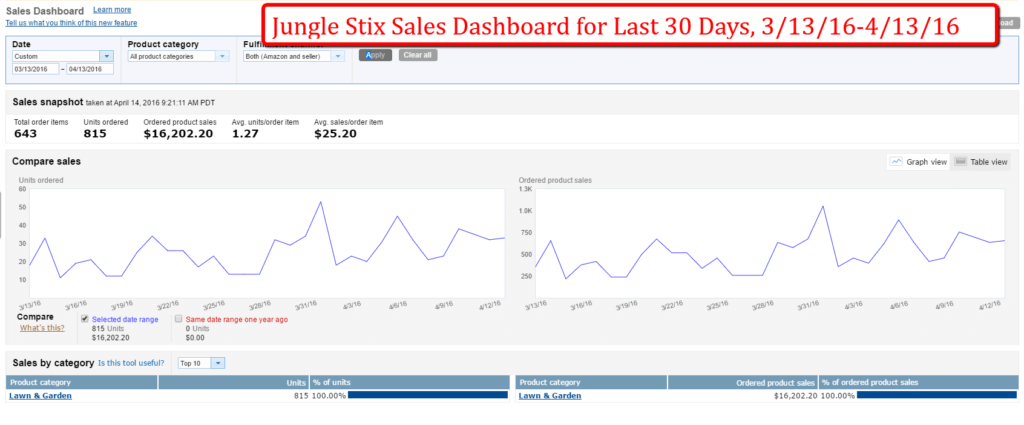
And with summer right around the corner, we are riding right into our peak season.
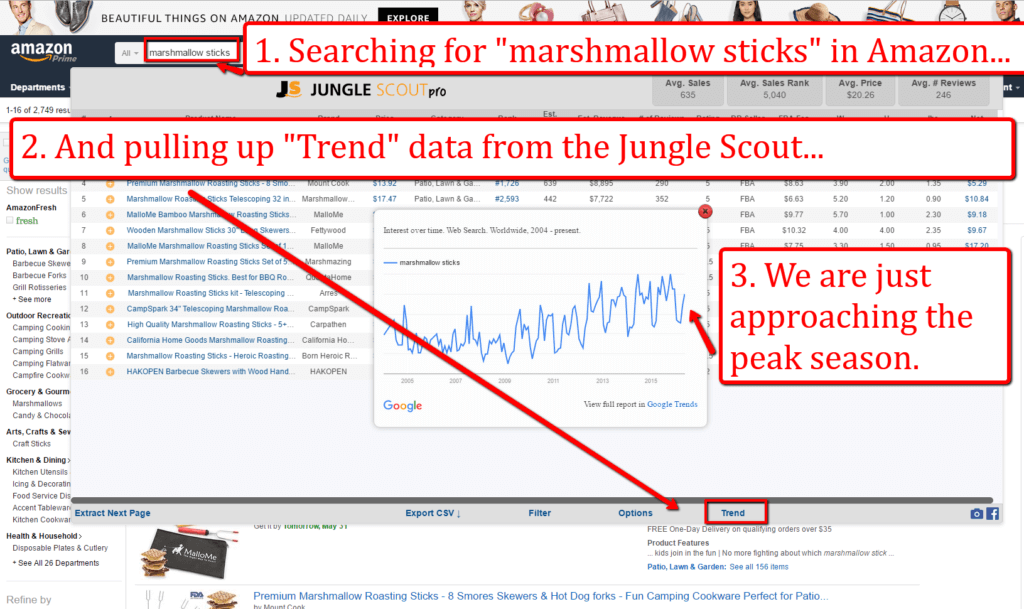
Well, this is the most recent snapshot of sales:
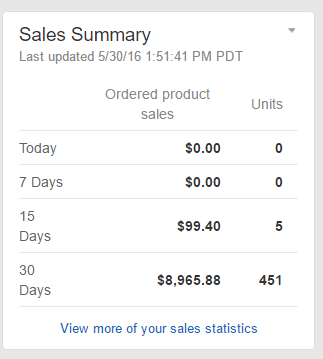
Jungle Stix have been out of stock for 14 days. Not the ideal position to be heading into the peak season, but a couple challenges will only make success that much sweeter!
When we started this case study of launching a private label product, I vowed to be fully transparent with the good, the bad, and the ugly. Guess where I’d categorize this? Yep, as an instructive lesson for me and you. So let’s dig into it further!
The Negative Impact of Having No Amazon Inventory
No Sales: This goes without saying, that without an inventory, you can’t get any sales. In fact, you will be “ghosted” on Amazon, and no one can even pull up your listing, even if they tried. The unfortunate thing isn’t even that you can’t generate money, but it is the related aspects of not having a listing: decreased keyword ranking, Best Seller Rank plummeting, and allowing the competition to catch up.
This is our listing in late February, where we had the #1 spot for a primary keyword:
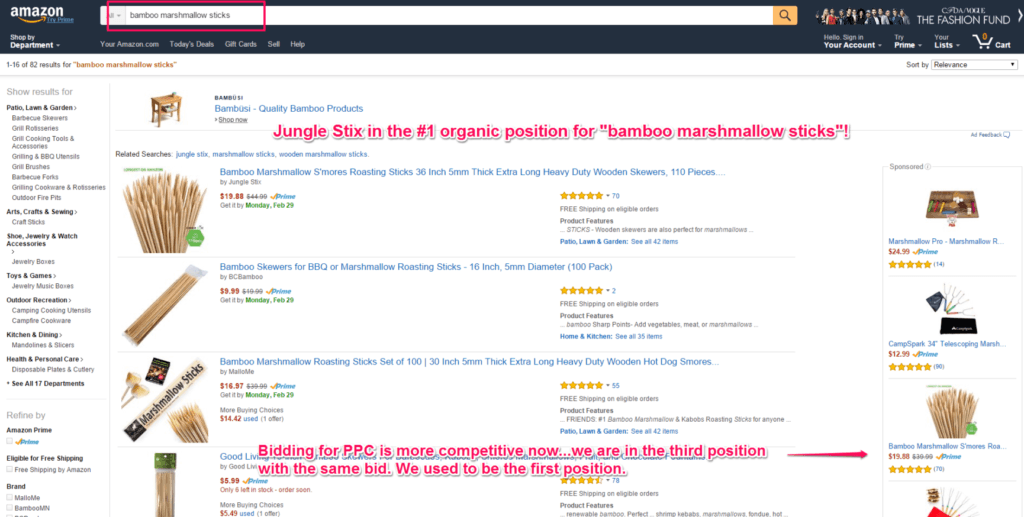
Competition gaining ground: When we launched Jungle Stix, one of the main factors that made it an attractive opportunity was that there was not a lot of competition. In other words, the top ranking products for the keywords “marshmallow sticks” did not have a lot of reviews. This is a key factor in how we got to the #1 ranked product in 53 days.
By not having a live listing for a month or so, we are allowing other competitors to accrue reviews while our listing is stagnant without improving the number of reviews.
If you have no #amazon inventory to sell, you lose money AND allow competitors to get more reviews. Click To Tweet
For example, if you look at the example above for the Amazon search results in late February for “bamboo marshmallow sticks”, the third result is by the MalloMe brand. At the time, they had 55 reviews, and it looks like all 5 star reviews.
I wanted to see how they were trending recently, so I pulled up their most recent sales data in the Jungle Scout Web App. You can see in the data below, which is found within the Product Tracker, that they are averaging 25 sales per day, even with 8 days of being out of stock. They are netting $9.18 per unit (after the $9.77 in Amazon fees is deducted).
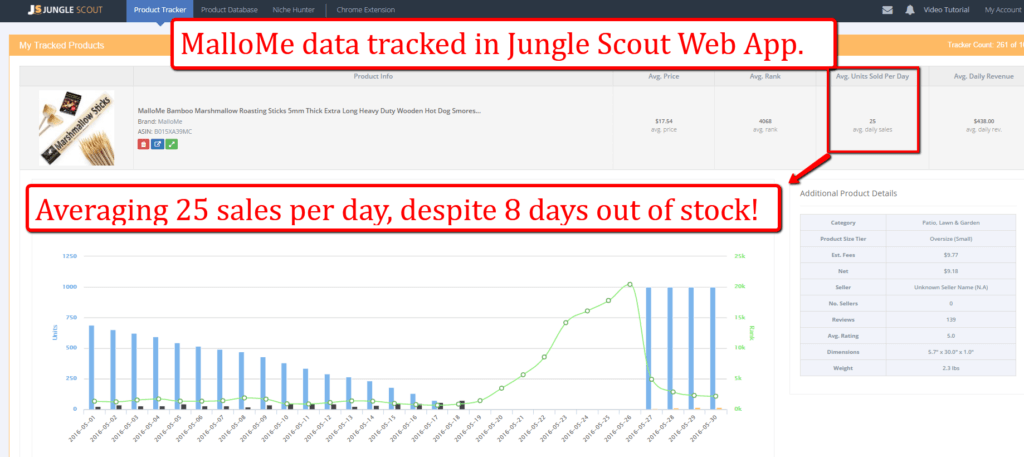
Also interesting to see is that during their stock out, their Best Seller Rank (represented by the green line) increases every day, until they are back in stock on May 27th. Then the BSR snaps right back into place, almost to where it was before the stock out. This could bode well for us as a similar product, that our Best Seller Rank will recover rather quickly when we are back in stock.
No Sales Velocity: In addition to not generating more reviews, our standing in the Amazon rankings for keywords related to “marshmallow sticks” is dropping. Who knows exactly what it is at the moment (remember, our dear listing is resting in the graveyard of Amazon listings, temporarily). However, when you consider that we are not getting impressions for any “marshmallow stick” searches, no clicks, and obviously no sales. We will figure out exactly what our uphill battle is when our listing is live again.
Until then, we can take a look at what changes we could have made along the way to avoid the position we’re currently in.
Mistake #1: Not Monitoring Sales Velocity vs. Inventory Available
Sales velocity is simply the rate at which items are selling. Sales velocity is generally applied to longer sales cycles, where there are specified leads and deal values and “win rates”.
However, it applies to our Amazon sales as well, by simply taking the average number of units sold per day, and figuring out how many days of inventory we have left.
For example, we were selling ~50 units per day in late April and early May. At that point we had several hundred units left, let’s say 500 units to make it simple. In that case, if we take the total units available and divide by our sales per day, we can the number of days remaining before running out of inventory.
So it would be 500 units / 50 units per day = 10 days of inventory remaining.
Amazon's Seller Central dashboard makes these calculations easy for you, with the Amazon Selling Coach. You can find the report here:
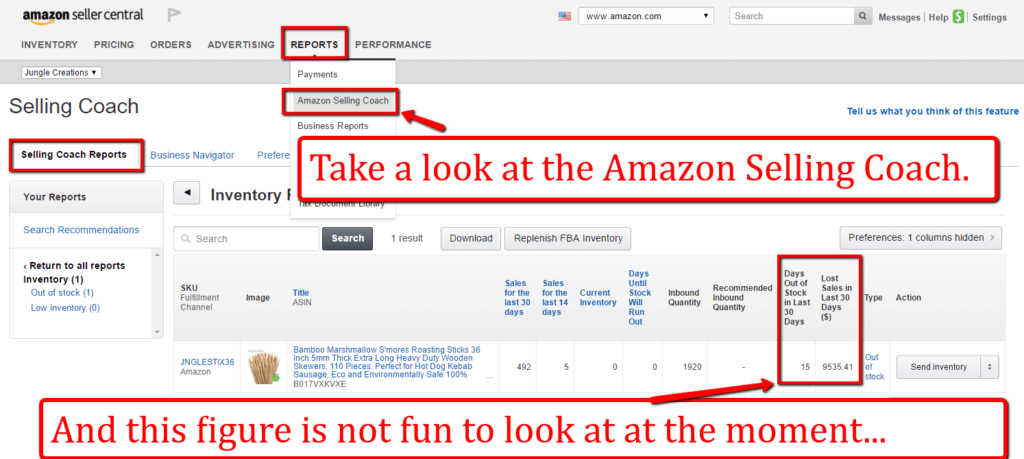
So take a look at your own Selling Coach, and note how many days until you are out of stock. This is a good gauge for when you should start restocking, and also how much you should restock.
The Amazon Selling Coach is a very helpful, under-used report to monitor inventory and stock outs. Click To Tweet
Here are some other important things to consider when managing your inventory:
- How long does it take your manufacturer to produce a new supply, from your first contact to getting it out of the warehouse?
- Are there any holidays that may affect the timeline? Obviously this is most relevant in February with Chinese New Year, but there are other Chinese holidays as well to keep in mind.
- Does the production time change depending on how many units I order?
- Do I have my whole supply chain set up? So once the order is ready to go, I can have my freight forwarder get it on the first ship bound to America! You can read more about shipping in our webinar with Shapiro here.
- What are the time and cost differences between ocean freight (slowest and cheapest), air cargo (a bit faster than ocean, and a bit more expensive), and air express (fastest and most expensive)?
- Is it worthwhile to batch the supply in different shipments to get some product to the warehouses faster so that we have less downtime without a listing? This is completely dependent on your product and competitiveness of niche. I don’t foresee too many challenges getting back to our top position for our main keywords, but for some hyper-competitive niches, a slip in rankings can be painful and have long-term negative consequences.
Mistake #2: Continuing To Run Pay Per Click Campaigns
If I did the calculation above, and thought that I would run out of inventory, I could have slowed sales. The easiest lever to control this would be pausing my pay per click campaigns immediately. These campaigns were converting at around 15% Average Cost of Sales, so are profitable campaigns to run. However, with limited inventory, it doesn’t necessarily do me any good to accelerate the depletion of inventory.
This is especially true for a product like Jungle Stix, which had already secured the top organic position for many of our main keywords. In the screenshot below, you can see that we are the #1 ranked organic product, and have great position for sponsored ads on the right column:
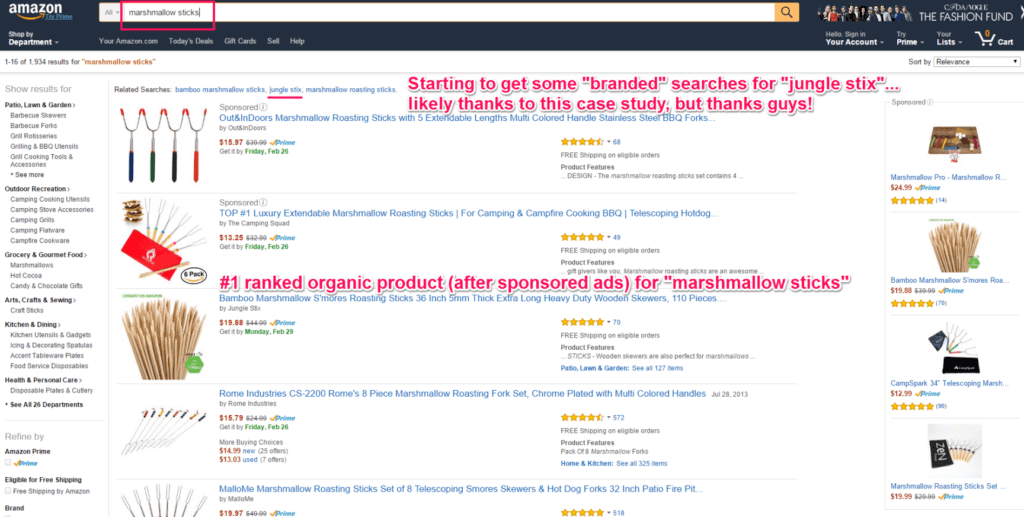
We were running paid ads for these keywords to increase our real estate on the search results page, and therefore increase the click through rate, whether on the organic listing or paid ad. If we removed the paid listing, we would have seen fewer visitors to our product page, and fewer sales. Having low inventory levels is one of the few times that we’d hope to get fewer sales!
Mistake #3: I Didn’t Adjust My Price
The other simple change I could have made to slow the inventory depletion is to raise the price. This is Economics 101: the higher the price point, the lower the demand. As the price decreases, then you move right on the “Quantity” axis:
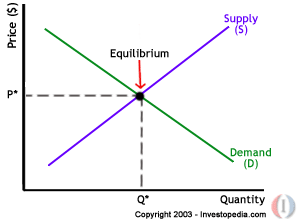
When we first launched Jungle Stix, we priced it at $27, as that was the “market rate” that competitors were charging. However, there were a few competitors who also launched similar products, at around $20, and after we saw sales slow down as a result, we lowered the price to $20. Our profit was only a few bucks per unit sold, but the strategy was that it was better to generate small profits with many orders as opposed to larger profits with just a few sporadic orders.
If we changed the price of Jungle Stix back to $27 once we saw that inventory was running low, we could have slowed our sales velocity and made the inventory last longer.
OK, so we’ve laid bare the mistakes that were made along the way to running out of inventory. What additional changes could we have made?
Inventory Management Solutions: How To Avoid Stock Outs In The Future
Stock More Inventory
It would have been easy if we just held more inventory at one time. We have been selling in quantities of 1000, because that is a healthy inventory number to launch with, and frankly I wasn’t sure how long this case study would continue. I figured that there were still some instructive lessons to learn from running the product and advertising campaigns (running out of inventory was an unintended lesson!), so I just kept restocking at levels of 1000.
For your own product, once you have proven customer demand, confirmed that you have found a reliable supplier who can execute as planned, and established that the unit economics are profitable, I would recommend stocking more inventory at one time to avoid running out of stock.
After you have proven demand and profitable unit economics, stock inventory more aggressively. Click To Tweet
Of course, there is a downside of holding too much inventory at once. There is the opportunity cost of tying capital up in inventory, as you can no longer use that money for other opportunities (ie launching a new product, running more promotions or advertising, investing in other non-Amazon asset classes).
Plan for Sales Increases & Seasonality
Like I mentioned above, the summer and fall months are high season for marshmallow sticks. To help plan for these months and the ideal inventory levels, we could look at Google Trends as a representative for what the increase in sales may be for these months. This is not going to be a wholly accurate prediction, but it would help by showing us how many more people are searching (on Google) for marshmallow sticks in say July vs March. We already have an idea of how many sales we were averaging per day and month in March, and we can just apply that growth rate in Google searches to the number of Jungle Stix sold.
And of course next year, if we were still selling Jungle Stix, we could just reference annual sales trends, which would be more accurate.
Use A Forecasting Software
These processes outlined above are great, in a perfect world. However, my world isn't perfect, life gets busy, and some small details may get overlooked. For example, days of inventory remaining. This is the exact use case for using an inventory management software to help track these metrics and get a better sense of when things need to be put into action in order to restock supply.
A software solution to this issue of knowing how much inventory to restock, when to order it, and where the shipment actually is can be a tremendous help in creating efficiencies, saving time, and ultimately money.
Proper inventory management is probably the easiest, yet least talked about area where most people can improve their FBA businesses. Order too much and your precious cash is tied up, order too little and you're losing out on sales. I've done a lot of research lately and all signs point to Forecastly being the best in the business at inventory management. For Jungle Stix we'll be in the lowest tier so it will only cost us $50/month. Considering each day we're out of stock costs us $80-$150 in lost profits, if Forecastly can save us 5 days/year of being out of stock – it will have a positive ROI. When I think about it like that, its a no-brainer and I am a little disappointed in myself for not signing up for it a lot earlier.
Next Steps
As you can see, the cost of the Jungle Stix stock out is not captured in just the lost revenue, but related costs of losing Best Seller Rank, keyword ranking, and the competitive edge (measured by reviews) over competitors. I hope to avoid this fate in the future, and hope that this experience will be a cautionary tale for you to take proper measures to not run out of stock.
Update since I first wrote this article: Jungle Stix are now back in stock! I will be running an aggressive promotional campaign on Review Kick*. Previously I have started with promotional giveaways of 30 units, but may increase that in order to accelerate our BSR recovery for peak season.
*Note: Update October 2016 – Due to changes in Amazon’s Terms of Service addressing incentivized reviews, utilizing promotions to get honest reviews is no longer allowed. Review Kick has now been relaunched as Jump Send, focusing on email communications to help Amazon sellers grow their business. Find out more information in our relaunch blog post.
We will keep you posted on how this process goes and what we experience after being restocked. What have your strategies to avoid running out of stock? And what are your effective strategies for bouncing back quickly and painlessly? Drop your insights in the comments below!

